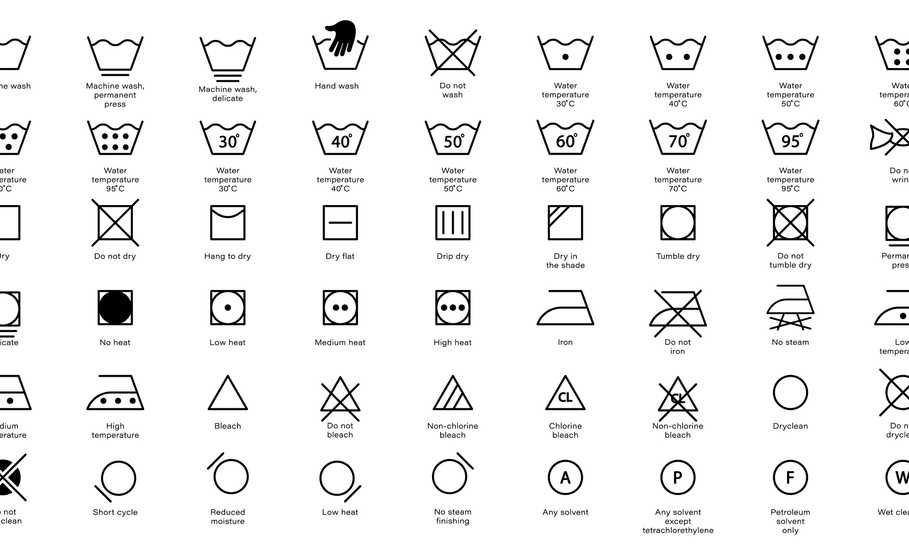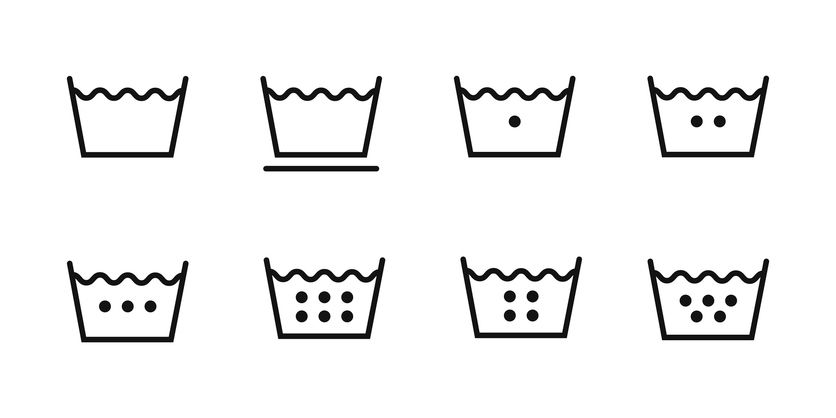How to Read Laundry Symbols

Our evaluations and opinions are not influenced by our advertising relationships, but we may earn a commission from our partners’ links. This content is created by TIME Stamped, under TIME’s direction and produced in accordance with TIME’s editorial guidelines and overseen by TIME’s editorial staff. Learn more about it.
We all have laundry horror stories. Maybe it’s a red shirt that got mixed in with the whites or a wool sweater that came out of the dryer three sizes smaller. Reading up on your clothing’s care instructions is key to keeping your wardrobe looking its best. But sometimes, those itty-bitty instructions on clothing tags can look like ancient hieroglyphics.
“Laundry directions and clothing should always be followed so nothing wrong happens to your garments. Going against instructions from the clothing and fabric can lead to damage, shrinking, color fading, or other issues,” says Daniel Feliciano, CEO and co-founder of Clotheslyne.
So, what do all those signs and symbols really mean? In this article, I’ll delve into basic laundry care, from water temperatures and dryer settings to ironing and bleaching, so you can decipher every symbol you come across.
Laundry symbols tell you all you need to know about cleaning a garment. Decoding these symbols will help you decide what cycle to use and what temperature to set the water for optimal cleaning results. Once you wash your garment, a separate group of drying symbols helps you choose from dry cleaning, hand drying, tumble drying, and other options. From there, you can look for more specific symbols for special treatments, like bleaching or ironing if your clothing requires those extra steps. Read on for a list of laundry symbols you’re sure to encounter on nearly every piece of your clothing.
The universal washing symbol is a three-sided tub that resembles your washing machine basin. Each of the symbols below is a variation of this three-sided tub, denoting specific washing instructions.
The simplest washing symbol, an open three-sided tub, means your garment is fit for machine washing.
A three-sided tub with a hand inside of it means the garment requires handwashing.
A three-sided tub with an X through it means the garment should not be washed. Read the tag for further instructions. This usually means the garment requires dry cleaning.
An open circle means your clothing must be taken to the dry cleaners when it becomes soiled or stained.
An open circle with an X through it means you cannot dry clean the garment. According to Tide, this means garments should be washed on your machine’s most gentle setting. Consider putting the garment in a mesh bag or turning it inside out to protect its integrity.
After you wash, you dry—but not all clothing is meant to tumble. Here’s a rundown of all drying-related symbols and how to decipher them.
A square, meant to depict your dryer, along with a large circle in the middle means your garment can tumble dry. But make sure you follow any further directions regarding temperature and time.
The same symbol but with an X through it means the garment cannot be tumble-dried. Read on for further instructions.
A square with a half circle toward the top of the symbol means your garment must hang to dry. You can do this by putting it on a hanger and leaving it to air dry.
A square with a line in the middle means your garment must be laid flat to dry. You can do this on any flat surface, but a dryer rack is always helpful.
While wringing out a piece of wet clothing might help it dry faster, it can harm certain fabrics. The twisted icon with an X through it means you cannot wring out your garment.
Temperature settings refer to the heat used when drying your clothing. Too much heat can damage certain items and not enough can leave you with wrinkles, so follow directions closely.
A square with a circle and a dot in the middle means your garment requires the lowest temperature setting on your dryer. This keeps the clothing from shrinking or losing its shape.
Medium heat is denoted by the same symbol with two dots in the middle. Set your dryer to medium heat for clothing with this symbol.
The same symbol but with three dots means high heat is required. You guessed it. Set your dryer to high heat.
A square with a solid circle in the middle means your garment can be tumble-dried with air only—not heat. According to Tide, you can hang these items dry or lay them flat.
Adding bleach to your machine’s wash cycle brightens whites or disinfects. But read washing instructions carefully, as bleach can do a lot of damage if not used correctly.
An empty triangle means bleaching is allowed. You can add the appropriate amount to your load for whitening, brightening, and disinfecting.
A triangle with an X through it means no bleaching. Bleaching clothing with this symbol can lead to discoloration and color fading.
A triangle with wavy lines means you can only use non-chlorine bleach. This bleach uses hydrogen peroxide or oxygen to get the same effect as chlorine bleach, but is less harsh on clothing.
If you thought washing, drying, and folding was a chore, don’t forget about ironing. Some pieces of extra special clothing need to be ironed to look their best.
An iron symbol with one dot means iron on low.
An iron with two dots means iron on medium.
An iron with three dots means iron on high.
An iron with an X through it means do not iron.
An iron with an X through the steam means you can iron it without steam.
According to the laundry experts with Swash Liquid Laundry Detergent, special symbols are also used for water temperatures and wash settings.
An open tub with one dot denotes cold water. According to the American Cleaning Institute, this is by far the most eco-friendly setting, as 90% of the energy used by a washer goes to heating the water.
Two dots mean warm water.
Three dots denote hot water.
A normal dryer cycle is denoted by a square with a circle in it. This is the most used setting and is great for basics like jeans, towels, sheets, and other frequently washed items.
If you see a square with a circle in the middle and a line under it, your garment needs a permanent press cycle, which removes wrinkles.
A circle in a square with three lines underneath means your garment should be put on the delicate or gentle dryer setting. This is the safest setting for delicate items.
Everyone has their own laundry tips and tricks, but I asked the pros for advice on how to get the best results.
A huge pile of laundry can be daunting. Sorting your laundry will make the task easier and help you gauge the size of each load.
“For perfect laundry every time, here are my top tips: First, sort your clothes by color and fabric type. This helps prevent bleeding and damage,” says Hyacinth Tucker, CEO of The Laundry Basket LLC. “Second, don’t overstuff the washing machine—your clothes need room to move around to get really clean. Third, use the right amount of detergent; too much can leave residue. And finally, air-dry when possible, especially for delicate items. It’s gentler and helps your clothes last longer.”
Directions are there for a reason. That’s why it’s so important to learn what all these symbols mean.
“Always keep in mind the instructions that come with your linens and try to follow them as closely as possible for long-lasting strength, color, and softness,” says Parima Ijaz, textile expert and founder of Pure Parima.
More does not always mean better. Using too much laundry detergent, fabric softeners, or scent enhancers can cause build-up.
“Avoid using harsh liquids and detergents, dryer sheets, fabric softeners, and powdered detergents as these contain high chemical levels which can cause damage to most linens. It’s safer to use mild detergents and a gentle cycle so that your linens don’t lose their quality and strength through multiple washes,” says Ijaz.
Undoubtedly, this is a lot to remember, so if you need a cheat sheet, a few apps that can help. You can download the Laundry Lens app from Apple iTunes or the Laundry Pro app from Google Play. Both are free.
If you're looking for a handy printout to hang in your laundry room, you can download one for free from Tide or buy one from Amazon.
Did you forget to read the laundry directions? It’s okay—it happens to the best of us. But be prepared for less-than-perfect results. Clothes that need to be dry cleaned are delicate and can lose their shape if washed in a regular washer. So you may end up with damaged fabric, bleeding colors, or shrinkage. Just remember those directions are there for a reason.
The information presented here is created by TIME Stamped and overseen by TIME editorial staff. To learn more, see our About Us page.


























